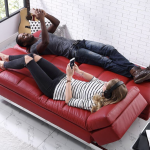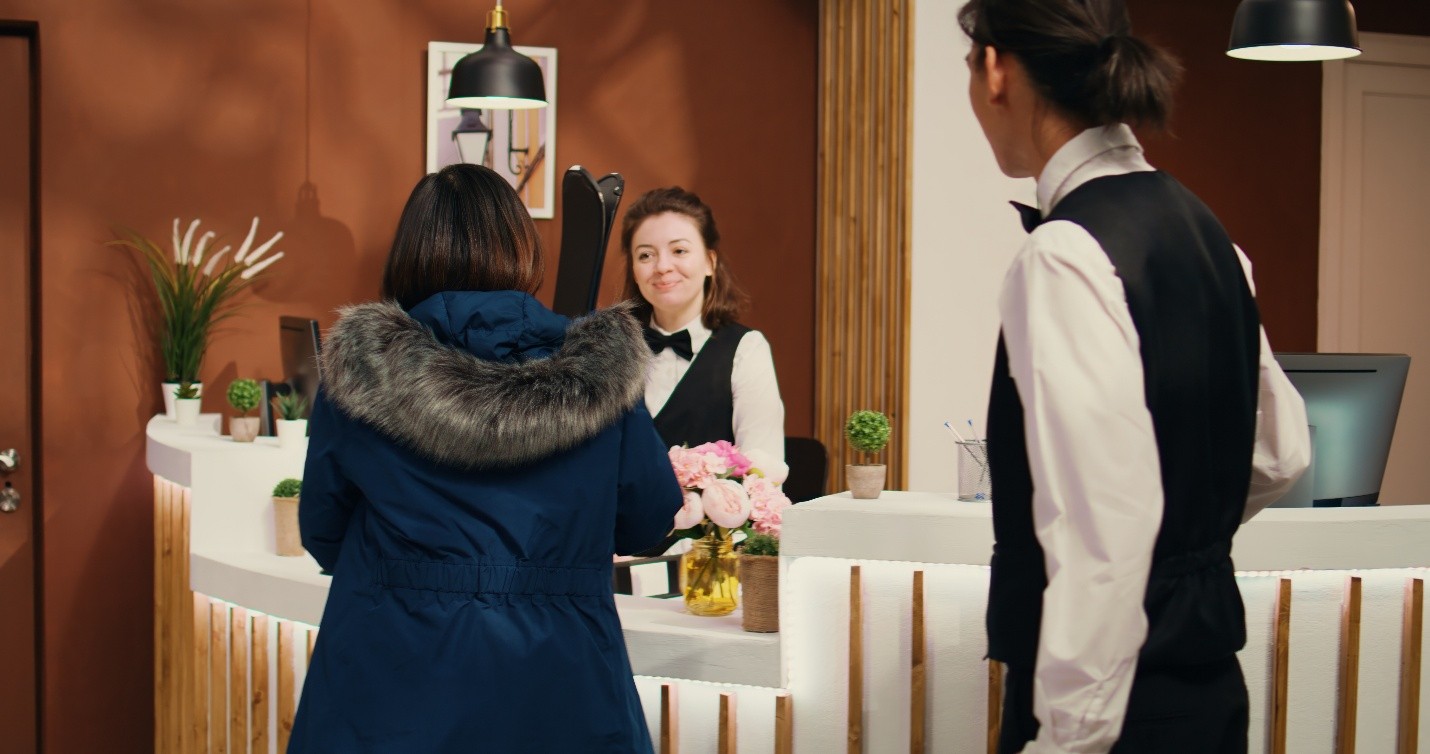
by adminbackup | May 28, 2025 | Blog
“Marketing is no longer about the stuff you make, but about the stories you tell.” – Seth Godin
In luxury hospitality, visibility is currency—but not the whole story.
The real value of PR isn’t press for press’s sake. It’s about putting your brand in the right hands, with the right language, at the right time—to drive bookings, elevate rate integrity, and build long-term brand equity.
At Chamberlin PR, we don’t just “get coverage.” We shape perception, open editorial doors that aren’t listed, and make sure your hotel becomes the one they remember, revisit, and recommend.
The Reality: Most Hotel PR Isn’t Built for ROI
Let’s be blunt. Most PR firms will get you “something.” A roundup. A local blurb. A line in a listicle. But visibility without strategy is just noise.
The truth is, luxury hospitality PR is not volume-based. You don’t need 50 mentions. You need the right 5—placed strategically, messaged precisely, and timed to influence rate and booking behavior.
Our clients come to us because they’ve outgrown generic coverage and are ready to invest in influence that performs.
Also Read: Why Your Hotel Needs a PR Agency
Real Results, Real Publications
Here’s what strategic hospitality PR firms looks like in practice:
Case Study #1: Boutique Napa Valley Estate — From Quiet Opening to Sold-Out Season
The Challenge:
A 12-room wine country retreat with generational ownership, reopening after a meticulous redesign. Gorgeous, but under-the-radar.
What We Did:
- Exclusive first-look feature in Travel + Leisure
- Followed by placements in AFAR, The Infatuation, and Robb Report
- Created a bookable narrative centered on design, terroir, and private access to winemakers
Outcomes:
- 100% booked for the next 8 weekends post-publication
- $45K in direct bookings attributed to PR within 30 days
- Guest ADR up 32% year-over-year
We didn’t just “get them press.” We launched them into their next revenue tier—without discounting a cent.
Case Study #2: Coastal Florida Rebrand — Turning Around a ‘Nice’ Hotel into a Desirable Destination
The Challenge:
An independent beachfront property with exceptional service but inconsistent brand perception. Review sentiment was lukewarm; occupancy was reliant on OTAs.
What We Did:
- Reframed brand story from “family-friendly” to “barefoot luxury”
- Secured profile features in The New York Times and Architectural Digest
- Built an influencer weekend around art, slow food, and Gulf beauty—resulting in 250K high-quality video views
Outcomes:
- 41% increase in direct website bookings
- Cut OTA commissions by 22%
- New partnerships with Amex Fine Hotels & Resorts and Mr & Mrs Smith
Case Study #3: New York Flagship Launch — Competitive Market, No Room for Missteps
The Challenge:
Global luxury brand launching its U.S. flagship in Manhattan. Short runway, high stakes, and a flood of openings in the same quarter.
What We Did:
- Curated a hyper-targeted editorial schedule across Forbes, Condé Nast Traveler, and Surface
- Hosted 8 pre-opening previews for top-tier editors and travel advisors
- Crafted messaging that emphasized global consistency with NYC edge
Outcomes:
- 12 features published before doors officially opened
- Hotel fully booked for launch month at full rack rate
- Owner retained Chamberlin PR for brand-wide U.S. strategy
The Chamberlin Difference: High-Touch, Founder-Led PR
Here’s where we diverge from other hospitality marketing agencies: you work with me.
There’s no bait-and-switch. No junior teams doing senior work. When you partner with Chamberlin PR, you get my media relationships, my editorial instincts, and my direct strategy.
That means:
- Your story is pitched by someone editors already trust
- Your messaging is developed by someone who knows what sells rooms
- Your brand never gets diluted in translation
We are proudly boutique for a reason—because white-glove PR demands it.
Our Sweet Spot: Boutique Hotels, Luxury Resorts & Destination Launches
We don’t do mass markets. We don’t do volume. We’re here for the brands that know their worth and want a PR partner who understands how to articulate it at the highest level.
If your hotel has:
- A distinctive design story
- A refined guest experience
- A leadership team that values long-term brand equity over quick traffic
We are likely the right fit.
Our portfolio includes:
- 5-star design-led resorts
- Restored historic inns
- Eco-luxury retreats
- Urban boutique brands with global ambitions
What Our Clients Value Most?
Our clients tell us they stay with Chamberlin PR because:
- They’re tired of surface-level PR that doesn’t connect to revenue
- They want to speak the language of luxury travel, not mass-market media
- They need someone who can get their brand into Vogue or CN Traveler and also explain how that’s going to affect Q4 bookings
And perhaps most importantly—they like that we make things easier, not harder.
PR That Drives Bookings, Not Just Buzz
Here’s how we make sure your best US and PR companies delivers bottom-line value:
- Editorial Strategy: Not all coverage is equal. We prioritize media that influences HNW travelers and travel advisors.
- Conversion Path Mapping: We track how readers move from article to booking engine.
- Rate Integrity Support: We use PR to justify your price point—and raise it.
- Brand Longevity: We’re building brands that hold attention year over year, not for 15 minutes.
We Know the Editors (And They Know Us)
Over the years, we’ve secured standout coverage in:
- Travel + Leisure
- The New York Times
- Condé Nast Traveler
- Forbes Travel Guide
- AFAR
- Robb Report
- Architectural Digest
- Monocle
These aren’t cold pitches. These are relationships built over a decade in luxury editorial and PR. We speak their language—and we know what lands.
High-Stakes PR for Brands That Want to Grow Smarter
If you’re ready to invest in long-term brand value—not just visibility—let’s talk.
Whether you’re debuting a reimagined retreat in the wine country or scaling a hotel brand across multiple destinations, you need a strategic partner who can translate your uniqueness into editorial gold—and bottom-line results.
That’s exactly what Chamberlin PR does. So, let’s build the story your guests can’t wait to experience.

by adminbackup | May 27, 2025 | Blog
The Tourism Industry No Longer Runs on Brochures – It Runs on Precision PR
Tourism is no longer a reactive industry. It’s strategic, high-stakes, and unforgiving to those who rely on generic messaging. As a travel PR agency, we’ve learned this firsthand. In 2025, your brand cannot afford to blend in. It must become the place, experience, or journey that travelers bookmark and share.
At Chamberlin Public Relations, we’ve worked with resorts that went from 30% off-season occupancy to sold-out retreats with six-month waitlists. We’ve helped under-the-radar cultural tours in Southeast Asia appear in Condé Nast Traveler and The Guardian, transforming them into sought-after experiences. The results weren’t luck. They were built through deeply tailored travel public relations strategies that understand this industry from the inside out.
The Rise of Precision PR in Tourism
In early 2024, we were hired by a luxury wellness resort in British Columbia. Stunning location, impeccable hospitality—but stagnant media traction. Their in-house team had sent over 300 pitches with barely any results. Why? Because they lacked the travel specificity.
We rewrote their story. Not just the copy—but the positioning. Instead of promoting “luxury getaways,” we framed it as a rare forest-to-spa immersion for stressed urban professionals. We built a media list of 90 hyper-aligned travel writers. Within 60 days, they were featured in AFAR, Well+Good, and a 4-minute segment on a morning lifestyle show in Canada.
This is what happens when travel public relations aligns with the emotional architecture of tourism.
Also Read: How Travel PR Agencies Boost Your Hotel’s Visibility
Why Generalist PR Can’t Serve This Market?
Tourism is not toothpaste or software. It’s aspirational, seasonal, emotional, and often subjective. A generalist PR agency may pitch your offering as “world-class,” but they won’t know when to activate your story, who exactly to pitch to, or how to wrap your region into a larger cultural narrative.
Here’s a quick comparison:
| Criteria |
General PR Agency |
Travel PR Agency (Chamberlin PR) |
| Press Outreach |
Broad, industry-agnostic |
Geo-targeted, outlet-aligned |
| Tone of Voice |
Product-first |
Experience-first |
| Media Relations |
Traditional corporate contacts |
Curated travel desks, freelancers, influencers |
| Messaging Timelines |
Static campaigns |
Seasonally responsive |
| KPIs |
Mentions and impressions |
Bookings, occupancy, brand lift |
We once took over a client from a corporate PR firm that had been sending press releases to Forbes Tech. They were a boutique hotel group. The disconnect was staggering.
What a Real Travel PR Campaign Looks Like?
When we launch a campaign, we don’t start with a press release. We begin by asking: Why will someone fly across the world for this? And then we reverse-engineer the entire campaign around that insight.
Let us walk you through a real example:
Client: A culturally immersive tour operator in Morocco
Challenge: Exceptional on-the-ground experience, zero digital footprint
Our Strategy:
- Built out a “7 Days in Morocco Through Local Eyes” press series
- Secured three influencers with documented Moroccan travel expertise
- Pitched to The Telegraph, National Geographic Traveller, Lonely Planet
- Coordinated a press trip during Ramadan to highlight the spiritual depth
- Produced a downloadable storytelling e-brochure for opt-in traffic
Result: 200% spike in website traffic, bookings increased by 65% in the first quarter post-campaign, and brand credibility soared among travel agents and DMCs.
We don’t tell stories for the sake of it. We craft narratives that move bookings, influence decisions, and build travel trust.
ROI You Can Actually Measure
Tourism clients rarely care about PR for vanity. They want bottom-line impact. So we focus our reporting around the KPIs that matter most:
| Outcome |
How We Track It |
| Occupancy Lift |
Week-on-week booking data post-campaign |
| Media Quality |
Domain authority, audience match, click-throughs |
| Brand Visibility |
Earned media reach + social shares |
| Organic Traffic |
Google Analytics before/after metrics |
| Lead Gen |
Email sign-ups via content magnets |
When we promoted a rainforest lodge in Costa Rica, one press feature in Outside Magazine generated over 600 organic leads in four days.
Real impact. Real metrics.
Why is Chamberlin PR Built for This?
We’re not just a hotel PR agency or a campaign vendor. We’re tourism advocates. Everyone on our team—from our PR strategists to our content editors—has a background in travel media, destination marketing, or luxury hospitality branding.
When we say we understand your space, we mean:
- We know when to pitch a ski resort in Switzerland (not during ski season, but 6 months prior).
- We know how to angle eco-conscious lodges for climate-aware travel outlets.
- We know which editors want culinary angles and which want heritage trails.
- We know the difference between a hotel that photographs well—and one that sells well.
Above all, we know how to make your brand the one travelers remember, not just scroll past.
Invest in PR That Moves People
If your tourism brand is still relying on templated press releases or diluted PR messaging, now is the time to evolve. A specialized travel PR agency brings more than media access—it brings the strategy and sensitivity required to make a lasting impression in one of the world’s most emotionally-driven markets.
Chamberlin PR is built for travel. We understand the rhythm of this industry. We speak the language of editors, influencers, and global travelers. And we back every campaign with data, creativity, and absolute dedication.
So, let us be the hotel PR agency or full-scale travel public relations partner that gets you there. Contact us today to schedule your strategy consultation.
Let’s turn your destination into a headline.

by Kelly | Jan 3, 2025 | Blog, hotel public relations agencies
Running a hotel or resort in today’s world is about more than offering great service – it’s about telling a story that resonates. Whether you’re a boutique hotel offering personalized experiences or a luxury property catering to global travelers, standing out in a crowded hospitality market is challenging. Did you know that 88% of travelers trust online reviews and recommendations over traditional ads?
That’s where we come in. A Hotel PR agency like Chamberlin Public Relations specializes in connecting your personalized story to the right audience, ensuring your property becomes the destination of choice.
What Does a Hotel PR Agency Do?
Think of us as your partner in showcasing your property’s strengths. Here’s what we focus on:
- Building Brand Awareness: Highlighting what makes your hotel unique – whether it’s stunning waterfront views, locally sourced dining options, or sustainability initiatives.
- Media Relations: Partnering with top-tier travel journalists and influencers to generate buzz and secure coverage in high-profile outlets like Condé Nast Traveler, Travel + Leisure, and leading digital platforms.
- Event Promotion: Driving attendance and visibility for signature events, such as chef-curated dinners, wellness retreats, or seasonal celebrations.
- Digital PR Campaigns: Using social media, SEO, and influencer partnerships to amplify your hotel’s reach and boost direct bookings.
Why Hiring a Hotel PR Agency Makes Sense
Stay Relevant in a Fast-Paced Industry
Hospitality trends shift constantly – from guest preferences to booking behavior. Chamberlin PR analyzes market data, monitors competitor strategies, and tailors PR campaigns that ensure your hotel stays ahead of the curve.
Get Your Hotel Noticed
Our deep relationships with travel writers, editors, and influencers mean your property gets featured in the right places. From in-depth editorial pieces to Instagram posts that inspire wanderlust, we connect you to the audiences that matter.
Boost Your Online Visibility
Your potential guests are searching for their next destination right now- are you on their radar? Through SEO-driven press releases, paid campaigns, and influencer collaborations, we make sure your property shines online and drives direct bookings.
Tell a Story Guests Remember
Why should travelers choose you? Whether it’s your rooftop dining with panoramic views, exclusive spa packages, or history-rich interiors, we craft stories that make your hotel unforgettable.
Why Chamberlin Public Relations?
At Chamberlin PR, we live and breathe hospitality. Our team has years of experience working with leading hotels and resorts, crafting strategies that deliver measurable results.
What Sets Us Apart?
- Tailored Strategies: Every hotel is unique, and we create PR plans that align with your property’s personality, goals, and target market.
- Proven Results: From increasing bookings to boosting online reviews, we focus on what matters most – your success.
- Full-Service Approach: Media relations, digital campaigns, crisis management – we cover it all so you can focus on your guests.
- Industry Expertise: With a portfolio that includes top-tier properties, we know what it takes to make your hotel stand out.
Ready to Elevate Your Hotel’s Visibility?
Your hotel deserves to be seen, experienced and remembered. Let Chamberlin PR help you craft a compelling story that connects with travelers and drives results.
📞 Contact Us Today
📧 info@chamberlinpr.com
🌐 Visit us at chamberlinpr.com
Let’s create something extraordinary together. Get started today– your next guests are ready to experience everything your property has to offer!
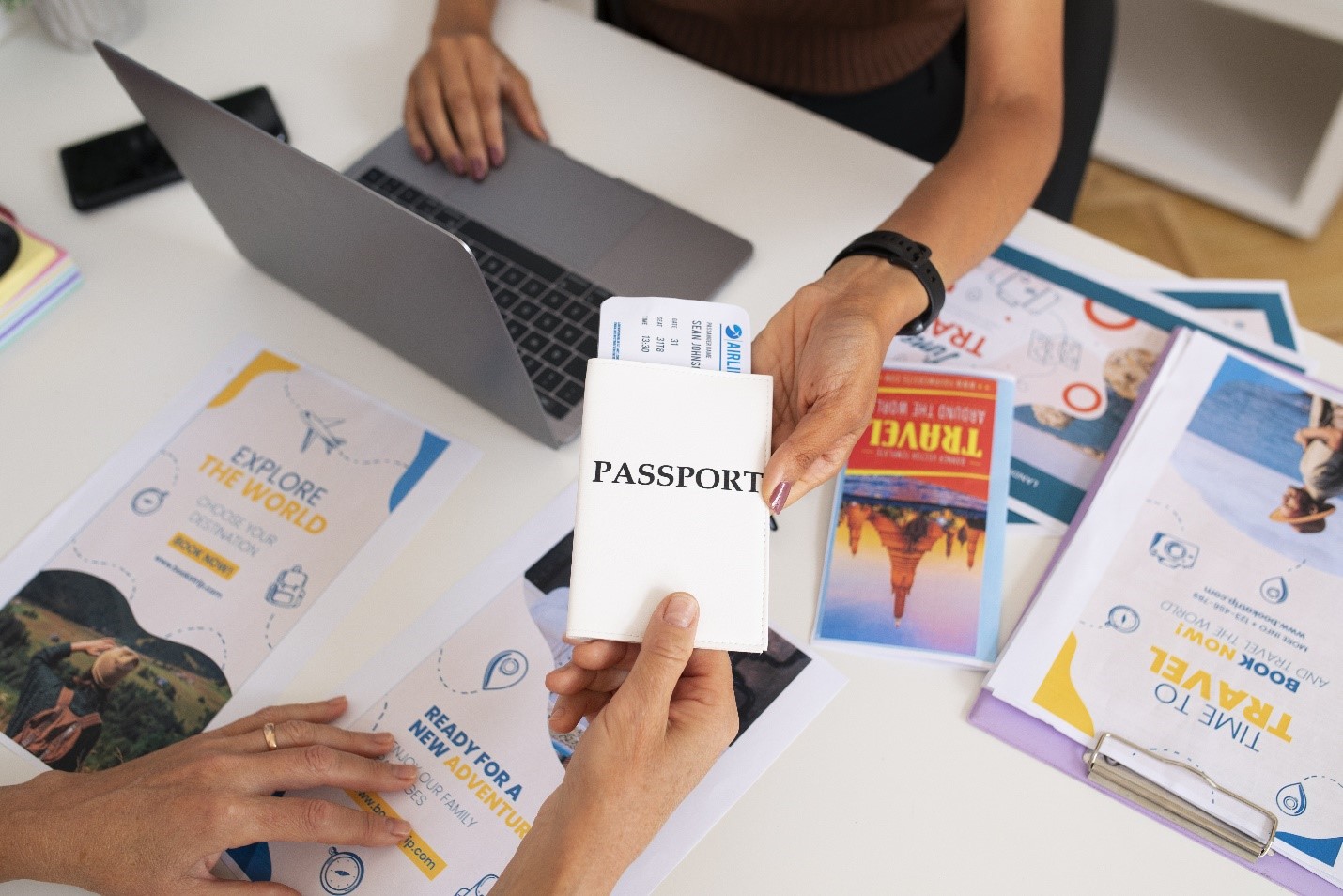
by Kelly | Sep 18, 2024 | Blog
Have you ever wondered how some hotels seem to be everywhere while others go unnoticed?
It’s not by chance, it’s a smart PR strategy. Travel Public Relations agencies specialize in boosting brand visibility, creating buzz, and positioning your hotel with the right audience. Through media outreach, influencer partnerships, and strategic campaigns, they craft stories that resonate with your brand.
However, for getting featured in top travel publications, securing influencer endorsements, or launching creative campaigns, it is important to choose an experienced travel PR agency that can put your brand at the top.
How Visibility Influences Travel Brands?
Travelers are bombarded with countless brands, each vying for attention. If your hotel lacks visibility, you risk blending into the background, making it difficult to attract new customers.
Brand awareness not only sets you apart from competitors but also builds trust and loyalty. When travelers consistently see your brand in magazines, social media feeds, and travel blogs, they are more likely to choose your services. Simply put, visibility influences consumer decisions.
What Does A Travel PR Agency Do?
Travel PR agencies offer a range of services designed to increase your brand’s visibility. Their primary goal is to get your brand in front of the right people and create a lasting impact. Here’s how they do it:
- Crafting compelling brand stories: They create narratives that resonate with your target audience and align with your brand’s values.
- Media outreach: PR agents maintain strong relationships with journalists and media outlets to secure press coverage.
- Influencer partnerships: They collaborate with trusted travel influencers to promote your brand authentically.
- Social media strategies: Agencies use social platforms to engage and excite audiences.
- Event planning: They organize events, such as press trips or product launches to bring your brand to the limelight.
Key Factors in Choosing the Right Travel PR Agency
Selecting the right PR agency is critical to your brand’s success. Here’s what to consider:-
- Experience in the travel sector: A PR agency with a strong travel media portfolio understands the unique challenges and opportunities in the industry.
- Media connections: Ensure the agency has a wide network of travel journalists and influencers.
- Understanding your brand: The agency should grasp your brand’s voice and message, tailoring their strategies accordingly.
- Innovative PR tactics: Look for agencies that offer creative solutions to stand out from the competition.
How Travel PR Agencies Build Relationships with Influencers
Influencers play a critical role in shaping consumer perceptions. Travel PR agencies know how to select influencers whose audience aligns with your brand. These influencers often have loyal followers who trust their recommendations.
When influencers share content about your hotel, it increases your visibility and credibility. However, not all influencer partnerships are created equal. PR agencies ensure that the influencers they work with represent your property authentically.
Getting Your Brand in Top Travel Publications
One of the most valuable services a travel PR agency offers is securing media coverage in high-profile travel publications. This kind of exposure is essential for brand credibility. These placements can make your brand visible to a wider audience.
But getting featured in these publications isn’t easy. It requires a PR agency with strong relationships with editors and journalists. These agencies know how to pitch your brand in a way that captures media attention.
Measuring Success in Travel PR
A successful PR campaign isn’t just about immediate visibility. Long-term success requires consistent measurement and analysis. PR agencies track metrics such as media mentions, audience reach, and engagement to gauge the impact of their efforts.
By measuring KPIs like brand recognition, social media growth, and press coverage, agencies can fine-tune strategies for even greater impact. This ensures that your brand remains visible and continues to grow over time.
Ready to make a difference?
Choosing the right travel PR agency can make all the difference in elevating your brand’s visibility. Chamberlin PR, with years of experience and a strong network of media contacts, is a leader in travel public relations. We have the tools and expertise to craft strategic campaigns that ensure your brand is seen, heard, and remembered. When it comes to boosting your travel brand’s visibility, partnering with an expert agency like Chamberlin PR is the key to success.

by Kelly | Feb 8, 2020 | Blog
If there’s one buzzword for the hospitality industry this year, it’s “connectivity.” Hoteliers are helping travelers feel more connected than ever to their destination, from food and beverage programming to design to the brand itself.
Here are three ways hoteliers can give their guests a truly special and authentic experience in the coming year, and beyond.
Fresh & Beautiful F&B
Hotel restaurant and bars have long since evolved from the bland watering holes of yore. Today, they are gathering spots for the whole community, where guests can meet one another and locals alike, forging new friendships and memories.
Programming in the restaurants and bars can go a long way toward fostering those connections. Last year, Marriott’s Four Points brand kicked off its “Best Brews Around the World” program, which presents a local craft beer at each property. The beer is selected based on taste, popularity, quality, and proximity to the hotel, giving guests a taste of the destination that they might not be able to find anywhere else.
An exclusive offering can be just as appealing as a local one. Earlier this year, Halekulani, an independent hotel in Waikiki, Hawaii, launched its Legacy Collection of Spirits developed exclusively for the hotel by France’s Delamain Cognac and Kentucky’s Heaven Hill Bourbon. While cognac and bourbon are certainly not native to Hawaii, the chance to sample beverages not available anywhere else can attract a wider range of guests to the bar.
Connected Design
If guests are going to share the story of their trip on social media, they’ll need to be able to charge their phones wherever they are, and designers are finding lots of ways to add outlets and USB ports without affecting the aesthetic of a space. For example, Gjemeni’s mid-century-modern-inspired couch has four USB ports and two 110-volt sockets as part of the furniture, making it easy for guests to charge up while they socialize.
At the latest BDNY conference, Samuelson Furniture introduced the Smart chair, a traditional-looking armchair (think antique leather and high-back wings) with a charging port hidden on the inside of the arm. The chair is also bluetooth-enabled that transmits sound using directional sound resonation rather than a conventional speaker system, so guests can listen privately to music without headphones.
Legrand, a specialist in electrical and digital-building infrastructure, recently launched table umbrellas with solar panels on top and USB ports at the base. These devices let guests recharge their phones while relaxing outside — and, since the units are solar-powered, hotels do not need to install additional wiring to hook them up.
Of course, while technology may make it easier than ever for guests to connect with the destination when they travel, one-to-one connectivity is still the best kind. A hotel with plenty of sofas and chairs in its lobby can help forge new friendships among guests and locals alike.
The Growth of Soft Brands
By their very nature, it’s easier for an independent hotel to stay authentic and to reap all the benefits of those buzzwords. On the other hand, corporate brands offer powerful support that make a hotelier’s life much easier.
Soft brands are a happy medium, offering the support of a powerful corporation but much of the freedom of an independent. Nearly every major hotel company has them now, representing everything from luxury (such as Marriott’s aptly named Luxury Collection) on down (like Red Roof’s Red Collection, which focuses on the upscale-economy to midscale). Soft-branded hotels are gaining ground in a wide range of destinations, from beaches to city centers, making it easy for guests to have an authentic, local experience wherever they go.
By joining a soft brand, an independent hotel can get all the support it needs back-of-house, including participating in the company’s rewards program, managing billing and expenses, and achieving higher rankings in search engines. At the same time, the hotel must live up to certain standards in order to maintain the relationship, so incoming guests will know that while their accommodation will not look like any other, it will still be something that suits their tastes.
The soft brand relationship with a major hotel company is much less restrictive than a traditional franchise deal, and the fees the brand receives are much lower than what a franchisee pays. The growth of these soft brands across the spectrum is a good sign of their appeal for travelers and hoteliers alike.
Guests want to feel connected to their destination, and a hotel that provides an “only here” experience can count on repeat visits. Personalized and local experiences combined with a sense that the hotel actually cares about their well-being will keep them coming back and generate positive word of mouth.
How are you partnering with local businesses to create special experiences? How are you helping your guests stay connected? And what do you think are some other trends we’ll see in 2019?
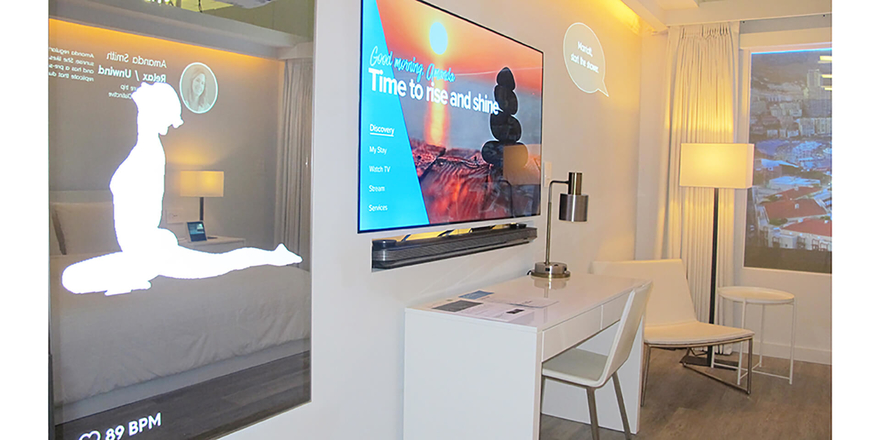
by Kelly | Dec 4, 2018 | Blog
More than ever, hotel guests want personalized experiences when they travel. But in this age of super technology, the idea of a “personalized experience” is rapidly changing. While guests still value having a concierge create a unique itinerary for them or receiving a special in-room amenity, the shift is now towards being able to curate their own experiences – from viewing movies and listening to music from their own playlists, to customizing the scent of their guestroom. Here are some of the ways hotels are using next-gen technology to meet these new demands.
Connected Rooms
Last year, Marriott International partnered with Samsung and Legrand to launch a hotel room focused on the “Internet of Things.” (Think WIFI-connected coffeemakers that can be programmed through an app.) The IoT Guest Room Lab allows multiple systems, devices and applications to communicate with one another. For example, a guest could ask a virtual assistant for a wake-up alarm, to start a yoga routine on a full-length mirror, request additional housekeeping services, and start the shower at the desired temperature stored in their customer profile, either by talking to an IoT-connected device or using an app.
Not to be outdone, Hilton announced the Connected Room late last year, a unique high-tech guestroom that lets guests personalize and control every aspect of their stay from their mobile devices. Guests who stay at Connected Room-enabled properties will be able to use the Hilton Honors app to manage many things they would do manually in a room, from controlling the temperature and lighting to the TV and window coverings. Guests will also be able to stream content from their media accounts on the in-room TVs and pick up right where they left off at home.
Looking ahead, Hilton plans to have guests staying in Connected Rooms use voice commands to control their room or access their content, and to upload their own artwork and photos to automatically display in their room. Guests will also be able to set preferences in their Hilton Honors account profile to further customize their in-room experience to their individual preferences.
Hilton is also working on personalization through its Innovation Gallery, an incubator and experiential showcase for new product developments. Some of these developments include Nightingale, a noise-masking product; Somabar, a personal mixology solution; Meural, a customizable digital art display; and Pilot, a real-time translation solution.
Personalization isn’t limited to entertainment, of course: Israeli company Moodo makes aroma diffusers that let guests customize the scent of their rooms. Upon entering their rooms, guests can pick a pre-set fragrance combination suggested by the Moodo app or use the app to mix fragrances and create their own unique scents.
The Future of Personalization
While all of these high-tech options are certainly impressive and buzzworthy, they also raise a question of what hotel guests will come to expect in the future. One of the joys of travel is discovering new and exciting things, like songs on local radio stations and diving into surrounding the culture. While the ability to bring all the comforts of home on the road can be nice, some of the best parts of traveling involve stepping outside of comfort zones and disrupting established routines.
In short — will people want to get away from it all, only to take it all with them?
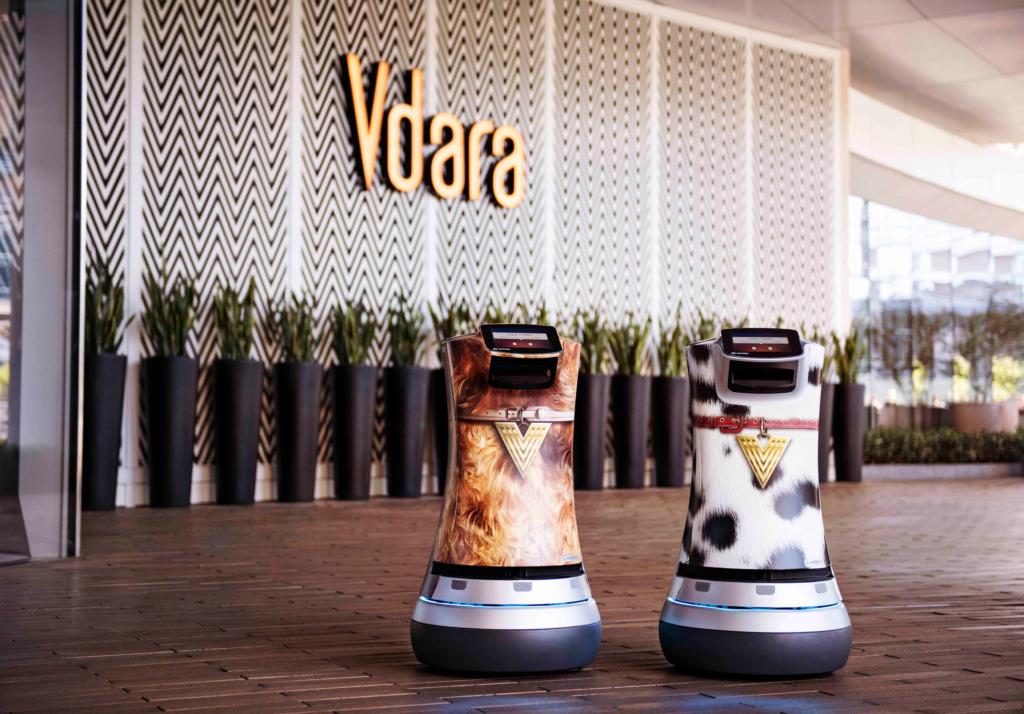
by Kelly | Oct 31, 2018 | Blog
It wasn’t so long ago that people would call a restaurant for a reservation, or go to the video store to see what tapes were available, or waited on the sidewalk for an empty taxi to drive by. Just as technology has made all of these practices obsolete, new technology is automating many of the processes that used to take up the valuable time of both hotel guests and team members.
But while these new devices may be the wave of the future, hoteliers should think carefully before trying to cut down on costs by opting for automation. After all, technology is not only as good as the engineer who designs it, it’s also only as useful as the person who uses it.
Lobby Kiosks
Much like supermarkets with self-serve lanes, some hotels have started offering self-service kiosks in their lobbies, allowing guests to check in, check out, and search for information without having to speak to a front desk agent or a concierge. For the better part of a decade, designers and hoteliers alike have been adjusting lobbies to incorporate these devices into luxury and midscale hotels alike, leaving the front desk agents to deal with more complicated matters while the machines handle the simpler tasks.
The kiosks aren’t limited to checking in, of course. In the spring, Marriott’s Aloft brand – one that does not always include a full-service on-site restaurant – updated its Re:fuel by Aloft food & beverage program to include digital kiosks that let guests place breakfast orders with a few taps on a screen. Much as with the check-in kiosks, these machines take care of the basic parts of the transaction, but a team member can help with any special requests.
And while many kiosks are easy to use and self-explanatory, some guests may have issues with the machines that cause delays – the very challenge the devices were meant to avoid. The Park MGM Grand in Las Vegas uses such kiosks, and a search on TripAdvisor reveals numerous complaints about the devices and requests for help from the staff.
In-Room Devices
People who are accustomed to walking in their front door and saying, “Alexa, turn on the lights!” will be happy to find “smart” devices turning up in guestrooms. KEYPR, a technology company that focuses on cloud-based platforms for guests and hoteliers, is rolling out its system at the Silver Reef Casino in Ferndale, Washington. Guests will be able to use a custom-branded mobile app that includes a mobile key and in-room tablets to expedite their check-in and check-out, order room service, communicate directly with hotel staff (for example, texting the valet to get their car ready), and get messages from hotel staff whether on or off property. The hotel can also receive guest feedback through the app in real time for active service recovery.
Hotel G in San Francisco has Roxy devices in all 152 guestrooms, enabling guests to issue commands through the voice-activated speaker to get hotel information, order extra towels and amenities, arrange check out, and other typical hotel tasks. Roxy then relays the message to the front desk without anyone having to make a phone call. The device can also do things such as play music, provide weather information, and set a wake up alarm.
Some devices blend into the guestroom’s decor. Last year, KEYPR partnered with Mirror Image Hospitality to create Remi, a “smart mirror” that doubles as a TV and a virtual concierge platform. Guests can use the mirror to find information about the hotel and surrounding neighborhood, order room-service, make reservations at nearby restaurants or just watch TV. The Savvy SmartMirror is a similar product that comes in a voice-activated model which is useful when a guest’s hands are full. The SmartMirror is expected to debut next year in the Sinclair Hotel in Fort Worth, Texas.
And in June, Amazon launched Alexa for Hospitality, a new program that gives hotels an Amazon Echo to act as a voice-activated virtual concierge in each room. Amazon installed Alexa devices in some properties (including the Wynn Las Vegas) to find out how guests responded, and feedback surveys came back positive.
Following the trial, Marriott International is rolling out the Alexa program in several of its properties, with each brand getting devices customized to its demographic. (Westin hotels, which have a strong wellness focus, will get Alexa devices with meditation playlists, for example.)
But not everyone is enthusiastic about these devices, especially machines that are voice-activated and have to listen to whatever is going on in the room. While guests who like “virtual” services at home may appreciate the same in their hotel rooms, others may want the option to completely disconnect them and maintain their privacy.
Delivery Robots
Room-service robots have also gained ground in several years in hotels, going from cool quirk to useful tools.
Many of these robots double as butlers, delivering amenities and room service items, like the Relay robot from Savioke, which can be seen at the Luma Hotel Times Square in New York City. Savioke also built Fetch and Jett, two dog-themed robots at the Vdara Hotel & Spa in Las Vegas, who started serving snacks and drinks to guests over the summer.
LG, meanwhile, announced the CLOi (pronounced KLOH-ee) line of hospitality-focused robots earlier this year. Each robot has a different role to fill in a hotel’s setting: The serving robot delivers meals and drinks, while the porter robot delivers luggage to guestrooms and can also handle express check-in/check-out service and take care of payment.
Pros & Cons
All of this technology, from the robots to the kiosks to the in-room devices, can help hotels improve efficiency and give guests a unique experience, and it can also boost a hotel’s bottom line. According to a recent article in the Telegraph, citing research by the Economist Intelligence Unit, the cost of labor has more than doubled since 1990, but robot prices have nearly halved over the same period. This makes replacing employees with robots appealing from a bottom line point of view, and one study estimated that up to 65 percent of Las Vegas jobs could be replaced by machines. Mary Giuliano, Vdara’s general manager, told the Las Vegas Sun that guests enjoy the novelty of getting deliveries from Fetch and Jett, and that the robots free up time for the rest of the staff to focus on requests that require a higher level of service.
But not every guest wants to work with machines, and with privacy concerns on the rise, more people may opt to unplug their in-room Alexa and ask the concierge for advice directly. After all, an app can recommend a nearby show or restaurant but it often takes a concierge’s connections to secure hard-to-get seats. While automation may be the wave of the future, true hospitality depends on human interaction, and no machine can replicate that.

by Kelly | Sep 28, 2018 | Blog
As more states ease laws on cannabis usage, hotels are finding new ways to incorporate the drug into their product offering, either catering to new demographics or offering new services for those eager to try something different and exciting.
According to a Gallup poll from late last year, more than 65 percent of Americans “support legalizing marijuana for both recreational and medicinal use.” So far, 31 states across the country now permit marijuana use in some form, even though the drug is still classified as “schedule 1,” meaning that it has a high potential for abuse. Even so, recreational use of cannabis is now legal in nine states as well as the District of Columbia, and businesses are jumping on the bandwagon.
After California legalized recreational use of marijuana earlier this year, the Desert Hot Springs Inn in the Coachella Valley began advertising itself as cannabis-friendly, allowing guests to smoke outdoors or using a vaporizer in the guestrooms. According to the Los Angeles Times, business improved by as much as 50%, while business at the 10-room Hicksville Pines Bud and Breakfast in Idyllwild increased by about 30% since its owner turned it into a “cannabis-centric property.”
But that uptick in business may not be enough for hotels across the state (and in other states where recreational use is legal) to permit guests to smoke up on property. Carl Winston, director of the school of hospitality and tourism management at San Diego State University, told the paper that there are significantly more problems with allowing marijuana on-site than there are benefits. For example, families may not want to stay in a smoke-friendly hotel, and a branded property that allows the use may cost sister hotels business from more conservative guests. And in terms of logistics, the cost of cleaning smoke from all of the textiles in a guestroom can be prohibitive. As such, many cannabis-friendly hotels may want to limit smoking to outdoor areas. For example, the 39-room Moment Hotel in West Hollywood only allows guests to smoke on the rooftop (this includes traditional tobacco products in addition to marijuana). Non-smokers, therefore, can breathe easy in the guestrooms and public areas.
If a hotel does not allow smoking on-site, it can still find other ways to cash in, especially with F&B. (After all, “edibles” are popular for a reason.) The Hollywood Roosevelt offers a mojito infused with cannabidiol (CBD), a non-intoxicating compound found in the cannabis plant, as well as three CBD-infused desserts. Peter Hansen, director of F&B for the hotel, told The New York Times that the CBD menu has proven popular, and guests have requested more options. The Thompson Seattle, meanwhile, has already offered several private dinners that include different strains of marijuana paired with food. More meals for the public are reportedly in the works.
Beyond edibles, CBD oil can be incorporated into spa treatments, like at the Spa Solage at Solage, Auberge Resorts Collection, in Napa Valley. The property offers a massage, facial and body scrub with CBD, promoting the treatments as helping to soothe insomnia, pain relief, anxiety and eczema. (It is worth noting that CBD, as a non-psychoactive compound, does not produce the same kind of “high” that THC, the psychoactive component of marijuana, does.)
Of course, there are pros and cons with integrating cannabis and marijuana into a hotel’s operations. If your state allows cannabis, will you incorporate it? We’d love to hear your comments!

by Kelly | Aug 1, 2018 | Blog
Virtual reality has quickly gone from niche to ubiquitous in the travel sector, with professionals in every facet of the industry finding a purpose for the technology.
Two uses stand out for the hospitality industry — attracting guests to a hotel or destination, and keeping them engaged once they’re there. Hotels across the country have already invested in VR, and guests are learning to expect a high-tech experience both before and during their stays. Here are a few ways hotels are already taking advantage of virtual reality to get heads in beds.
Virtual Guests, Real Bookings
Virtual reality can give potential guests a taste of a hotel or destination pre-stay and help them book with confidence. If they can look around the space in advance, they’re less likely to face disappointments when they arrive.
Best Western Hotels & Resorts has the Best Western Virtual Reality Experience, a high-definition, 360-degree look into all of the company’s 2,200 North American properties. Each video gives guests an interactive tour of the hotel’s pool, lobby, fitness center and guest rooms, all in less than two minutes. Before making their reservations, potential guests can examine everything from the rooms to the types of chairs they will be sitting in. Earlier this year, Best Western was recognized by Fast Company magazine as one of the “Top 10 Most Innovative Companies” in the AR/VR category.
Last year, the Hilton Waikiki Beach made a virtual reality tour as part of its app and its website. Using their desktop computers, guests can go on a 360-degree tour and click on “hot spots” to learn more about anything they see. They can also put on VR headsets with their phones and virtually walk through the space.
It isn’t just hotels that are using VR to boost interest. Convention centers and destination marketing organizations have jumped on the bandwagon as well. The Palm Springs Convention Center launched an interactive 3D map and virtual tour through a partnership with Concept3D. Event planners and attendees can explore the whole 245,000 square feet facility, including the integrated 410-room Renaissance Hotel. All of the exhibit halls and outdoor spaces are displayed, and the map has a button so planners can request a proposal while they browse.
The Santa Clara CVB recently partnered with virtual travel platform Xplorit to create an aerial overview map of the city with integrated waypoints and 360-degree exploration of the city’s convention center, hotels, event spaces, and attractions. David Andre, vice president of marketing and communications at the Santa Clara CVB, told Meeting Planners International that VR was the “wave of the future” for promoting a destination or venue. Visitors spend an average of four minutes and 45 seconds on the website, Andre said, and that kind of immersion can easily becoming a booking.
On-Site Entertainment
Some hotels are incorporating VR into the onsite guest experience, keeping guests entertained on-property and making rainy days a little less dull.
In Las Vegas, the MGM Grand Hotel & Casino and Zero Latency launched a multiplayer free-roam VR experience inside the 2,000 square feet Level Up gaming lounge last year. The arena, “Virtual Reality Powered by Zero Latency,” allows up to eight people to play in an interactive digital world together, encouraging collaboration as opposed to isolation. Multiplayer games can include zombie apocalypse stories or physics-based puzzles that are good for families to play together.
“When it comes to playing games, and exploring new worlds in virtual reality, more people means more fun,” Zero Latency CEO Tim Ruse said when the project opened. “Technology can often be isolating but we are determined to continue to design games and experiences that bring people together for mind-blowing VR adventures and to forge real memories that can last a lifetime.”
Other hotels around the country have added VR game rooms to their public spaces. The Aventura Hotel, one of the Loews Hotel at the Universal Orlando, has a virtual reality game room where guests can play with motion tracking controllers for a unique family experience. In Arizona, the Trailblazers recreation center at the Fairmont Scottsdale Princess has a virtual roller coaster with specialized VR chairs.
The Viceroy Group’s Hotel Zetta in San Francisco introduced the VR “cube” installation in the lobby, designed by local upstart Exit Reality. The Exit Reality cube offers a broad range of top-tier content including Google Tilt Brush and Alazan Studio’s Holopoint, so guests can select a VR journey tailored to their interests. Aligning with Hotel Zetta’s focus on creativity, health, and mindfulness, Exit Reality has also curated a selection of custom experiences including Guided Meditation VR from Cubicle Ninjas. The hotel plans to expand the Exit Reality relationship in the future, adding the technology in guest rooms and offering exercise equipment that pairs with the VR system.
There are plenty of ways hotels can incorporate virtual reality into the guest experience, and new ones are coming online constantly. As travel planners and travelers alike become more tech-savvy, VR can help make sure that not only are their expectations met, but exceeded.














